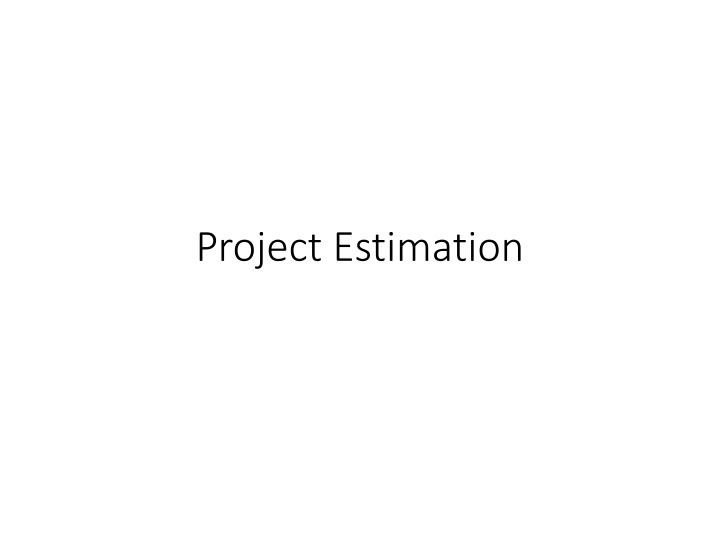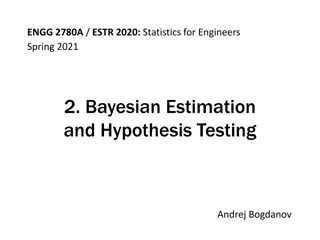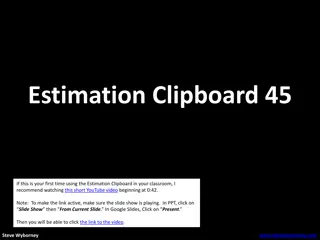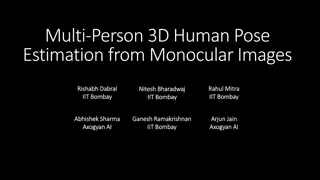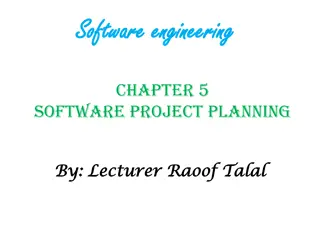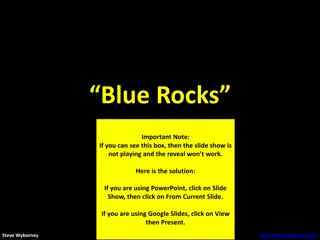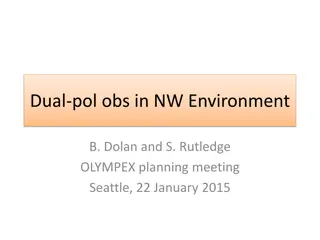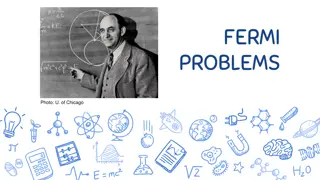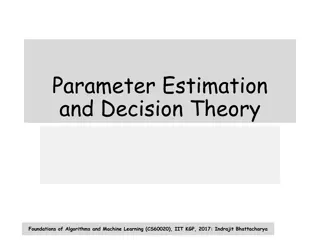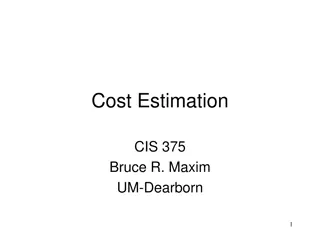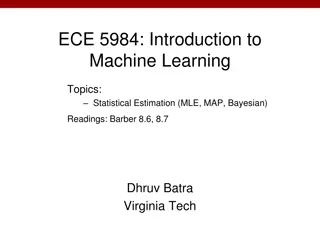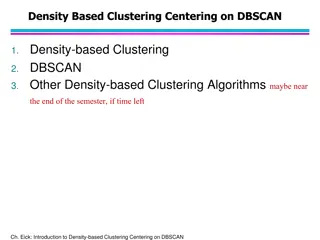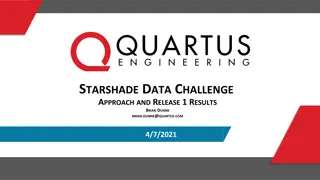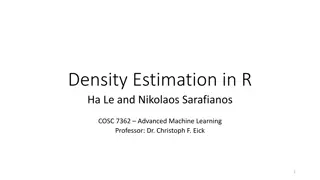Effective Project Estimation Techniques
Project estimation is vital for success, involving inputs like human effort, project duration, and costs. Discover the importance of precise estimates and reasons for inaccuracies, along with key estimation techniques. From expert judgment to estimation by analogy, learn how to navigate uncertainties and make informed decisions in project planning.
Download Presentation

Please find below an Image/Link to download the presentation.
The content on the website is provided AS IS for your information and personal use only. It may not be sold, licensed, or shared on other websites without obtaining consent from the author.If you encounter any issues during the download, it is possible that the publisher has removed the file from their server.
You are allowed to download the files provided on this website for personal or commercial use, subject to the condition that they are used lawfully. All files are the property of their respective owners.
The content on the website is provided AS IS for your information and personal use only. It may not be sold, licensed, or shared on other websites without obtaining consent from the author.
E N D
Presentation Transcript
Planning Prerequisites The planning process requires the following inputs: Required human effort (man-months) Project duration (months) Project costs ($) We would like our estimates to be perfectly precise and accurate But this requirement is impossible until the project is over 2
Importance of Estimates In the early days of computing, Software costs were a small part of the total system cost Even large errors (order of magnitude) = little impact on the total system cost Today, software costs are the largest component of total system cost Large errors in estimating cost equate to The difference between profit and loss or Survival and demise 3
Reasons for Inaccuracy in Estimates Too many uncertainties in the variables that determine the cost In the following categories Human The developers and their skills are not perfectly known Technical May need to use new or unfamiliar technology Environmental May need to run on unfamiliar computer or operating systems Political Internal company or client politics 4
Estimation Techniques Five main categories of techniques Expert judgment Estimation by analogy Pricing to win Parkinson pricing Algorithmic models 5
Expert Judgment Several experts in the application domain independently prepare estimates Estimates are compared (together with the rationale for the estimate) Differences are resolved by discussion It is not Estimation by committee An averaging of the independent estimates 6
Estimation by Analogy Cost of a new project is estimated by analogy to similar systems previously developed Identify differences and estimate cost of these differences How to handle no previously developed similar systems? What about changes in development environment? How to handle employee turnover? How to handle new language, case tools, 7
Pricing to Win The cost is what you believe the customer is willing to spend What circumstances would lead you to price a project this way? 8
Parkinson Pricing Parkinson s Law Parkinson s Law The work expands to fill the time available Cost is determined by available resources rather than by objective analysis Example If the software is needed in 1 year and you have 5 developers available to work on the project, the effort is 60 man-months 9
Importance of Deviation It is important to identify changes from previous projects, especially when employing Expert Judgment or Estimation by Analogy Failure to identify change and account for its influence Distorts the estimate Perhaps to the point that the estimate is of little value 10
Importance of Deviation (cont) Examples of change affecting estimates Object-oriented versus structured techniques Client-server systems versus stand-alone applications COTS components versus developed components Reuse versus all new development CASE tools / code generators versus unsupported development 11
Algorithmic Models A formula (or set of formulae) is evaluated to provide an estimate Size or functionality metrics are the independent variables Constants in the formula are based upon historic cost data 12
Algorithmic Cost Modeling The most systematic approach to cost modeling The most precise method, but Don t confuse with the most accurate A formula or set of formulae is used to predict cost based on project size, and sometimes other project factors Most algorithmic cost models have an exponential component Realizing that cost does not scale linearly with size 13
Algorithmic Modeling (cont) The simplest model is a static single-variable model = B Effort A Size Where A is a constant factor Factor incorporating process, product and development characteristics code size or a function oriented value B A constant typically in the range of 1 to 1.5 Size 15
Size Metrics Two common categories of size metrics Lines of code Function oriented metrics While lines of code (LOC) not the only size metric LOC is the most commonly used measure of size 16
LOC Metric LOC Metric There are two different ways of implementing LOC Lines of Code (LOC or KLOC) Count all lines Thousand of delivered source instructions (KDSI) Count of the physical source statements, includes: Format statements Data declarations Excludes Comments Unmodified utilities 17
Problems associated with lines of code as a metric 1.Lack of Accountability: 2.Lack of Cohesion with Functionality: 3.Adverse Impact on Estimation: 4.Developer s Experience: 5.Difference in Languages: 6.Advent of GUI Tools: 7.Problems with Multiple Languages: 8.Lack of Counting Standards: 9.Psychology: 18
Lack of Accountability: Not useful to measure the productivity of a project using only results from the coding phase, which usually accounts for only 30% to 35% of the overall effort Lack of Cohesion with Functionality: Effort may be highly correlated with LOC, but functionality is not so much! skilled developers may be able to develop the same functionality with far less code, developer who develops only a few lines may still be more productive than a developer creating more lines of code Adverse Impact on Estimation: Because of point 1 estimates based on lines of code can adversely go wrong Developer s Experience: Implementation of a specific logic differs based on the level of experience of the developer. Hence, number of lines of code differs from person to person. An experienced developer may implement certain functionality in fewer lines of code than another developer of relatively less experience does, though they use the same language. Difference in Languages: Consider two applications that provide the same functionality (screens, reports, databases). One of the applications is written in C++ and the other application written in a language like COBOL. The number of function points would be exactly the same, but aspects of the application would be different. The lines of code needed to develop the application would certainly not be the same. As a consequence, the amount of effort required to develop the application would be different 19
Advent of GUI Tools: GUI-based programming languages and tools such as Visual Basic, allow programmers to write relatively little code and achieve high levels of functionality. a user with a GUI tool can drag-and-drop and other mouse operations to place components on a workspace. Problems with Multiple Languages: software is often developed in more than one language depending on the complexity and requirements. Tracking and reporting of productivity and defect rates poses a serious problem in this case since defects cannot be attributed to a particular language subsequent to integration of the system. Lack of Counting Standards: There is no standard definition of what a line of code is. Do comments count? Are data declarations included? What happens if a statement extends over several lines? Organizations like SEI and IEEE have published some guidelines in an attempt to standardize counting, it is difficult to put these into practice since new languages being introduced every year. Psychology: A programmer whose productivity is being measured in lines of code will have an incentive to write unnecessarily verbose code. This is undesirable since increased complexity can lead to increased cost of maintenance and increased effort required for bug fixing. 20
Function Oriented Metrics Based upon a higher level of abstraction Identify and score high level functionality We will example two metrics FFP Based on three characteristics: Files, flows and processes Function points Based on five characteristics Input items, Output items, Inquiries, Master files, Interface 21
FFP Proposed by van der Poel and Schach Medium Size Projects ( 1- 10 man years) Identify and score 3 basic structural elements Files, Flows, and Processes 22
Structural elements Files Permanent files only Do not count temporary or transaction files Flows Interfaces between the product and the environment Input / Output Screens Reports Processes Functionally coherent manipulations of data Sorting Validating Transforming 23
FFP (cont) Size The size is the sum of the Files, Flows and Processes Files Size + = + Flows Processes Cost The product of Size and a constant d Constant varies from organization to organization Based on historic cost and size data d Cost = Size 24
FFP (cont) Note: This metric is based upon the functionality of the application High level property of the system Can be more accurate earlier in the life-cycle than LOC metrics 25
Class Exercise An application maintains 8 files: a sorted master data file, 3 index files, 1 transaction file and 3 temporary files. It has 3 data input screens, 3 display screens, generates 4 printed reports, and 6 error message boxes. The processing includes sorting the master file, updating transactions, calculating report data from master file data. Assume a value of 800 for d . Determine the Size and Cost using FFP. 26
FFP Summary Advantages A simple algorithmic model Based on easy-to-count characteristics of a high level design Disadvantages All items are equally weighted Requires historic data based upon a particular organization Has not been extended to correctly count databases Something unsettling about adding unlike quantities 27
Function Points A similar approach taken by Albrecht Based on 5 functionality characteristics Input items, output items, inquiries, master files, and interfaces First calculate the number of unadjusted function points = + + + + UFP C Inp C Out C Inq C Maf C Inf 1 2 3 4 5 28
Function Points (cont) The constants are determined from the following table C 1 ... 5 C Characteristic Input items Output items User Queries Files External interface Weight 1 ... 5 (Simple, Average, Complex) 3 4 4 5 3 4 7 10 5 7 6 7 6 15 10 29
Function Points (cont) The next step is to calculate a technical complexity factor Each of 14 technical factors is assigned a value from 0 to 5 0 - Not present or no influence 5 - Strong influence throughout The degree of influence DI obtained by summing the above values 30
Function Points (cont) 1 2 3 4 5 6 7 8 9 10 Reusability 11 Ease of installation 12 Ease of operation 13 Maintainability 14 Multiple Sites Data communication Distributed data processing Performance criteria Heavily utilized hardware Online data entry End-user efficiency Transaction Rate Online updating Complex computations The 14 technical factors are: 31
Function Points (cont) Calculate the technical complexity factor TCF TCF . 0 65 . 0 + = 01 * DI TCF values are in the range of 0.65 to 1.35 Finally the number of function points FP is calculated from TCF UFP FP = 32
Function Point Calculations You may find the following template useful Characteristic Input Items Item Complexity Medium ____ * 4 = ____ Low High Total ____ * 3 = ____ ____ * 6 = ____ Output Items ____ * 4 = ____ ____ * 5 = ____ ____ * 7 = ____ User Queries ____ * 3 = ____ ____ * 4 = ____ ____ * 6 = ____ Master Files ____ * 7 = ____ ____ * 10 = ____ ____ * 15 = ____ Ext. Interfaces ____ * 5 = ____ ____ * 7 = ____ ____ * 10 = ____ Unadjusted Function Points Technical Complexity Factor 0.65 + 0.01*____ Adjusted Function Points 33
Class Exercise An application has 5 simple inputs, 4 complex inputs, 30 average outputs, 5 simple queries, 10 average master files and 8 complex interfaces. The degree of influence is 50. Calculate the number of unadjusted function points and the number of function points. 34
Simple Object-Oriented Estimation Simple four step model developed by Lorenz and Kidd The number of estimated classes served as the size parameter 35
The Four Steps The Four Steps 1. Determine the number of problem domain classes in the application Determine the interface and the associated weight Calculate the number of total classes by multiplying the number of problem domain classes by the interface weight and add it to the number of problem domain classes Calculate the number of man-days by multiplying the total number of classes by a productivity constant in the range of 15 - 20 2. 3. 4. 36
Interface Weights Interface Type Weight No user interface 2.0 Simple text-based interface 2.25 Graphical user interface 2.5 Complex graphical user interface 3.0 37
Class Exercise An object-oriented application has an estimated 50 problem domain cases and a graphical user interface. Assuming a productivity constant of 18, calculate the number of man-days that will needed to develop the application. 38
COCOMO COCOMO is a static single variable model COCOMO is an acronym for Constructive Cost Model that was developed by Barry Boehm The COCOMO models are defined for three classes of software projects. (1) organic mode (2) semi-detached mode (3) embedded mode 39
COCOMO COCOMO is actually a hierarchy of models of the following form Basic COCOMO estimates software development effort and cost as a function of program size in lines of code Intermediate COCOMO - estimates software development and cost as a function of program size in lines of code and a set of cost drivers Advanced COCOMO incorporates the characteristics of intermediate COCOMO with an assessment of the cost driver impact on each phase of the software development cycle 40
Project Types/Levels of COCOMO The level of difficulty was broken into three modes Organic Mode Constraints on development are mild Many similar projects previously developed by the organization Relatively small, simple software projects in which small teams with good application experience work to a set of less than rigid requirements (e.g., a thermal analysis program developed for a heat transfer group) Semi-detached Mode More constraints on development, but some flexibility remains Few similar projects previously developed by the organization An intermediate (in size and complexity) software project in which teams with mixed experience levels must meet a mix of rigid and less than rigid requirements (e.g., a transaction processing system with fixed requirements for terminal hardware and data base software) Embedded Mode Very tight constraints No similar projects previously developed A software project that must be developed within a set of tight hardware, software and operational constraints (e.g., flight control software for aircraft). 41
Effort Computation The Basic COCOMO model computes effort as a function of program size. The Basic COCOMO equation is: E = aKLOC^b Effort for three modes of Basic COCOMO. Mode a b 2.4 1.05 Organic 3.0 1.12 Semi- detached Embedded 3.6 1.20 42
Example 43
COCOMO (cont) The intermediate model calibrated on 40 software development projects Further work revealed certain difficulty factors that dramatically influenced the effort estimates and schedule 44
Intermediate COCOMO Calculations Intermediate COCOMO calculations proceed by First, determine the mode (organic, semi-detached, embedded) This determines the constants A - D Mode Organic Semi-Detached Embedded Constants B 1.05 1.12 1.20 A 2.4 3.0 3.6 C 2.5 2.5 2.5 D 0.38 0.35 0.32 45
Intermediate COCOMO (cont) Second, using the appropriate constants from the previous table, calculate the nominal effort and schedule from ) ( * nominal KDSI A E = B (Nominal Effort) Third, calculate a difficulty multiplier that depends upon the cost drivers (include subjective assessments of attributes in the general areas of ) Product Hardware Personnel Project 46
Intermediate COCOMO (cont) Fourth, the adjusted effort E is the nominal effort Enominal multiplied by the difficulty multiplier Fifth, the project duration is calculated from Schedule = D ( * ) (Duration in Months) C E 47
Effort Computation The intermediate COCOMO model computes effort as a function of program size and a set of cost drivers. The Intermediate COCOMO equation is: E = aKLOC^b*EAF Effort for three modes of intermediate COCOMO. Mode a b 3.2 1.05 Organic 3.0 1.12 Semi- detached Embedded 2.8 1.20 48
Effort computation(.) Effort Adjustment Factor Cost Driver Very Low .75 Low Nominal High Very High 1.40 Extra High 1.40 .88 1.00 1.15 Required Reliability .94 .94 1.00 1.08 1.16 1.16 Database Size .70 .85 1.00 1.15 1.30 1.65 Product Complexity 1.00 1.00 1.00 1.11 1.30 1.66 Execution Time Constraint 1.00 1.00 1.00 1.06 1.21 1.56 Main Storage Constraint .87 .87 1.00 1.15 1.30 1.30 Virtual Machine Volatility .87 .87 1.00 1.07 1.15 1.15 Comp Turn Around Time 1.46 1.19 1.00 .86 .71 .71 Analyst Capability 1.29 1.13 1.00 .91 .82 .82 Application Experience 1.42 1.17 1.00 .86 .70 .70 Programmers Capability 1.21 1.10 1.00 .90 .90 .90 Virtual machine Experience 1.14 1.07 1.00 .95 .95 .95 Language Experience 1.24 1.10 1.00 .91 .82 .82 Modern Prog Practices 1.24 1.10 1.00 .91 .83 .83 SW Tools 1.23 1.08 1.00 1.04 1.10 1,10 Required Dev Schedule Each of the 15 attributes receives a rating on a six-point scale that ranges from "very low" to "extra high" (in importance or value). The product of all effort multipliers results in an effort adjustment factor (EAF). 49
Effort Computation (..) Total EAF = Product of the selected factors Calculating Adjusted value of Effort or Adjusted Person Months: E= (Total EAF) * ENominal 50
